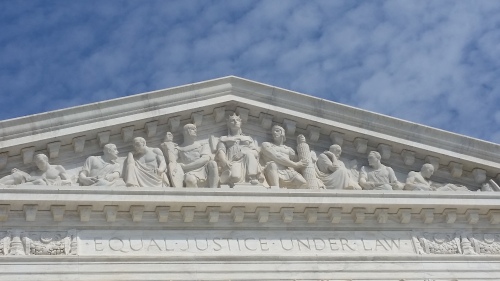
This blog started twenty months ago with a post titled “Why Vetting Matters.” That post noted:
“The modern appointments process involves several layers of “vetting” of potential judicial nominees. Candidates are generally first evaluated by their home state Senators and their staff. Then, they are vetted again by the White House Counsel’s office and the Department of Justice. They are then examined by the FBI and the American Bar Association (ABA). Upon their nomination, their records are scrutinized by the Senate Judiciary Committee, as well as interest groups on all sides of the political spectrum. At each level of review, the vetters seek to ensure that the candidate meets their personal and ideological criteria for appointment.”
Today, what we are seeing with regard to Judge Brett Kavanaugh is a failure of that process. A compelling and credible allegation of sexual assault has been raised against the judge, an allegation that did not surface during the vetting that he underwent for the Supreme Court, nor during his prior vetting for his current seat on the D.C. Circuit. Some have used this point to suggest that the allegation, raised by Dr. Christine Blasey Ford, should not be believed. I would argue, rather, that it is an indictment of our current vetting process and its limitations.
As noted in our opening post, the current vetting system for judicial nominees involves several entities, including the White House, the Department of Justice, the FBI, and Senate staff. In their investigation, the “vetters”, depending on their particular role, review all the written and background material submitted by the nominee, do criminal background checks, and conduct interviews with the nominee’s friends, colleagues, and associates. Again, depending on their role, the vetters might be looking for ideological inconsistencies, intellectual ability, or issues with the nominee’s truthfulness or character. The involvement of these different entities, along with outside groups such as the American Bar Association, is, in theory, supposed to ensure a thorough vetting of any nominee.
In practice, however, there are still holes in this process. Take allegations of sexual assault, for example, comparable to those made by Dr. Ford. Where the allegations have not been reported to the police, they will not show up in a criminal background check. Unless there has been news coverage or some public record of the allegations, they will not show up in Google or record searches. Furthermore, unless the nominee volunteers the information, it will not be revealed in the disclosures. As such, investigators generally probe such allegations of misconduct in their private interviews with the nominee’s friends, family, and colleagues.
However, even these interviews are unlikely to reveal such misconduct. Most DOJ, FBI, and ABA interviews are conducted either with friends and colleagues invested in the nominee’s success, or, with opposing counsel and judges who are too far removed to be aware of, let alone comfortable revealing, any allegations of impropriety. As such, unless an individual alleging misconduct is directly interviewed, it is unlikely that their allegations would be revealed in the interview process.
In the case of Judge Kavanaugh, the flaws in the vetting process may have been magnified by its speed. Justice Anthony Kennedy announced his retirement from the U.S. Supreme Court on June 27, 2018. Judge Kavanaugh was announced as the nominee on July 9, just 12 days later. In comparison, President Obama nominated Justice Sotomayor 26 days after Justice Souter’s leaked retirement in 2009, and Justice Kagan 31 days after Justice Stevens’ retirement in 2010. Similarly, his nomination of Judge Merrick Garland in 2016 came 31 days after Justice Scalia’s untimely passing. While Justice Gorsuch’s nomination came 11 days after President Trump’s inauguration, it was to a vacancy that had been pending almost a year. Even assuming that Judge Kavanaugh had been partially vetted before Justice Kennedy’s retirement, the pace of his nomination was still incredibly fast.
Similarly, the Senate Judiciary Committee held a hearing on Judge Kavanaugh less than two months after his nomination despite the Committee not having a chance to look over significant portions of his record. As such, at the time of the hearing, only one of the 21 Judiciary Committee senators was even aware of Dr. Ford’s allegations.
At any rate, any deficiencies in the process could have been corrected once Dr. Ford’s allegations went public. At that point, the White House could have reopened Judge Kavanaugh’s background check, allowing the FBI to investigate the allegations (something they have done hundreds of times before). The White House chose not to. The Senate Judiciary Committee could have chosen to take sworn testimony from Dr. Ford’s corroborators, including those with whom she shared the allegations, and those who could corroborate the events in question. The Committee chose not to.
Instead, the American people were subjected to the spectacle of a sexual assault survivor being cross-examined by a prosecutor, while a gallery of stone-faced senators watched. No other witnesses were called, and no follow up questions were asked. If it was not for a carefully-negotiated rebellion on the part of Sen. Jeff Flake, there would have been no follow-up from Dr. Ford’s testimony at all.
Regardless of what the reopened FBI investigation uncovers, this saga has already laid bare the weaknesses of the current vetting process. Perhaps there is no foolproof way that unreported allegations of sexual assault can be uncovered through the vetting process. However, it is important to recognize that. Given the documented barriers to reporting sexual assault claims, there are likely other unreported claims against other federal judges and nominees. As such, the next time that similar allegations are raised against a nominee, vetters may need to look in the mirror before asking why the allegations were not uncovered earlier.
This blog reflects solely the views of the author and does not reflect the positions of any of the other writers or researchers at the Vetting Room.